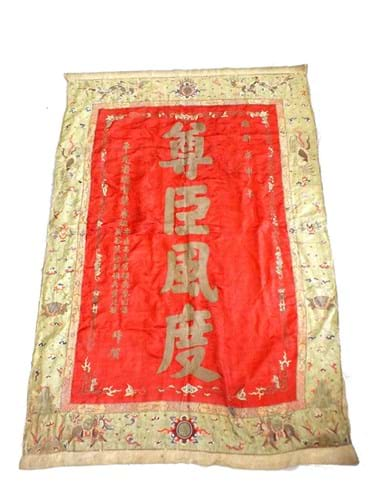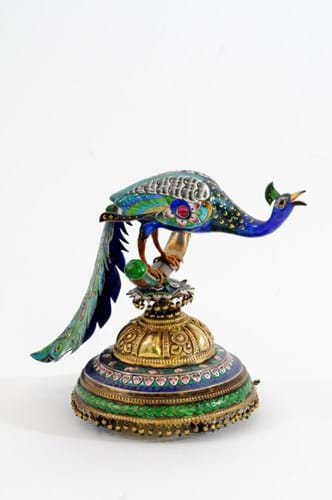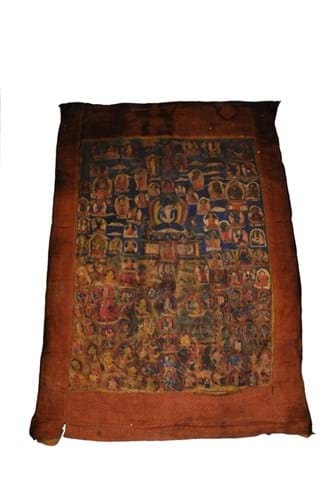
Jeremy Lamond is sitting in a bright, ultra-modern office deep in Shropshire at Halls’ Shrewsbury headquarters when ATG calls in. His mind is far away, namely in the Asian buying hubs of Beijing, Hong Kong and Taiwan.
That’s because this week, Halls mounts one of two annual Asian sales and Lamond predicts that bidding will again be driven by Chinese buyers based in those far off regions, rather than those London or Europe.
Buyers of the sale’s Japanese art, on the other hand, are more likely to be from London, he notes.
It’s well documented that as the Chinese economy has slowed in the past three years, demand for its art has become less heady and more selective. “The Asian market is very focused right now,” Lamond says. “It’s not the free-for-all it was in 2010.”
Halls’ sale this week is itself more selective, with 120 lots (its main Asian sale this year will happen in November, timed to coincide with the influx of buyers that happens during the Asian Art in London festival).
The item with the highest estimate in this week’s sale may be an imposing 21.25in (54cm) high famille verte porcelain vase, Kangxi period, pitched at £8000-12,000, but the object Lamond gets most animated about is another Kangxi-period piece, rather different in scale.
1. Chinese porcelain 'month' cup, Kangxi mark and period – estimate £300-400

This rare Chinese porcelain 'month' cup, Kangxi mark and period stands at 2.5in (6.6cm) diameter and comes with a hardwood stand. Sets of 12 cups are unusual and ones in good condition can fetch five figures. Halls' cup carries a low estimate £300-400 because of a significant crack.
This Chinese porcelain 'month' cup (lot 300) is Kangxi mark and period, painted in wucai colours with a flowering pomegranate tree that represents the fifth month. Standing at 2.5in (6.6cm) diameter and 1.9in (5cm) high, it comes with a hardwood stand.
An underglaze blue poem translates as: 'The colour unfolds like the sun on pearl curtains, The breeze bears the fragrance in the shade of the whitewashed wall.'
The ultra-delicate cup also bears a seal reading 'shang' (to appreciate) to one side, underglaze blue six-character Kangxi mark within a double blue circle.
A famille-verte ‘crabapple’ month cup, also Kangxi mark and period and of the same dimensions, sold at Sotheby’s New York in September 2018 for $68,750 inc premium (£52,808).
The example at Halls carries a low estimate reflecting its condition: it is obviously “badly cracked,” as the catalogue puts it, and “we don’t know what that will do to its hammer price,” Lamond says.
Given their fragility, complete sets of 12 month cups are very rare, Lamond says, though the Palace Museum in Beijing does have a set.
His high hopes for this cup rest on a collector missing the fifth month and willing to put up with condition issues to complete their set.
2. Large Chinese red silk wall hanging – estimate £300-500

Lot 222 is a large Chinese red silk wall hanging is Qing dynasty, dating from winter 1908 and was a gift from the emperor to a general, with a provenance to Coton Hall in Shropshire. It measures 135cm wide and 210cm high and carries an estimate of £300-500.
This Chinese wall hanging (lot 222) is Qing dynasty, dating from winter 1908 and has a provenance to Coton Hall in Shropshire. It measures 53in (135cm) wide and 82.7in (210cm) high.
Research by Halls revealed that this hanging was a gift from the emperor to a subordinate, rewarding and congratulating them for their service. The recipient was a general from Pingding County in Shanxi Province named Pei Chunxuan.
On the hanging’s left-hand side are two lines of poetry honouring the general’s excellence in commanding soldiers, use of weaponry, spreading political messages and Japanese language skills.
The piece features gold embroidered vertical script and smaller surrounding script, a wide gold border with coloured decorative detail of turtles, dragons and other creatures and patterns.
3. Indian gilt and silver enamelled peacock – estimate £300-500

Donated to a charity shop and now consigned for auction by the same charity, this Indian parcel gilt and silver enamelled peacock on a meenakari-work base is 19th century and is the sale catalogue’s cover star.
Donated to a charity shop and now consigned for auction by the same charity, this Indian parcel gilt and silver enamelled peacock on a base (lot 276) is 19th century and is the sale catalogue’s cover star.
The brightly enamelled bird sits on a perch, mounted on top of an elaborate base featuring exquisite meenakari enamelling work, with two borders of suspended beads. The base, engraved with a flower-head design, itself sits on four blue enamel feet.
4. 18th/19th century thangka of Samantabhadra and Samantabhadri – estimate £300-500

Thangkas are Tibetan Buddhist paintings executed on cotton or silk appliqué, usually depicting a Buddhist deity, scene, or mandala and used as movable shrines. This 18th/19th century thangka of Samantabhadra and Samantabhadri is unframed, 89cm x 61cm and estimated at £300-500.
Thangkas are Tibetan Buddhist paintings executed on cotton or silk appliqué, and usually depict a Buddhist deity, scene, or mandala.
“Thangkas were used as movable shrines,” Lamond says and there are two in the Halls sale on May 15, consigned by a private seller whose parents acquired them in Tibet in the 1930s.
This one (lot 318) features a deity seated on a lotus throne in dhayanamudra and surrounded by attendants, the upper register against a midnight blue ground, the lower register against a green ground, gouache on cotton.
Unframed, it measures 89cm x 61cm, the entire panel 118cm x 78cm.
5. A Japanese carved ivory study of the lunar hare, Late Edo period – estimate £200-300

Lot 330 is a Japanese carved ivory study of the lunar hare, Late Edo period and estimated £200-300. Dating from mid-19th century, and with a hairline crack, the hare is carved at lodge with finely detailed features and amber eyes, and is 2.5cm high and 3.5cm in length.
This minute carved ivory hare (lot 330) is a personal favourite of Lamond’s, partly for its topicality as a subject. “It brings to mind The Hare with Amber Eyes, the family memoir written by British ceramicist Edmund de Waal, who has two exhibitions at the Venice Biennale this year.”
Dating from mid-19th century, and with a hairline crack, the hare is carved at lodge with finely detailed features and amber eyes, and is 2.5cm high and 3.5cm in length.
Demand for antiques ivory objects, Lamond notes, has not slowed ahead of the ivory ban coming on to UK statute books later this year.





